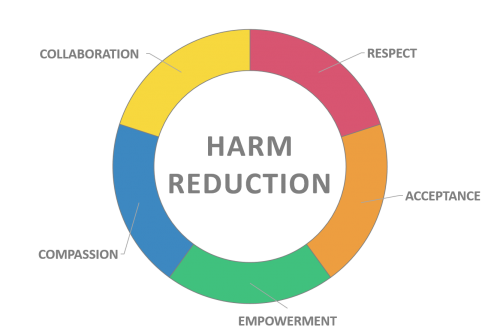What is harm reduction?
Harm reduction includes policies, programs and practices that aim to keep people safe and minimize death, disease, and injury from high risk behaviour, especially psychoactive substance use. Harm reduction recognizes that the high risk behavior may continue despite the risks.
Harm reduction involves a range of support services and strategies to enhance the knowledge, skills, resources, and supports for individuals, families and communities to be safer and healthier.
A range of services is available to prevent harms from substance use. Some examples include:
- Needle distribution/recovery programs that distribute sterile needles and other harm reduction supplies, recover used needles and other supplies, and provide information and containers for their safe disposal.
- Substitution therapies that substitute illegal heroin with legal, non-injection methadone or other prescribed opioids.
- Take home naloxone program that provides an antidote to opioids to reverse an overdose thereby preventing brain injury, due to depressed breathing, and death.
- Supervised consumption facilities that help prevent overdose deaths and other harms by providing a safer, supervised environment for people using substances.
- Outreach and education services that make contact with people who use substances to encourage safer behavior.
- Peer support programs that are groups run and attended by people who use substances to improve their quality of life and to address gaps in services.
- Impaired driving prevention campaigns that create awareness of the risks of driving under the influence of alcohol and other legal or illegal substances.
What are the benefits of harm reduction related to substance use?
Harm reduction has many benefits for people who use substances, their families, and communities. Research shows harm reduction activities can:
- Reduce hepatitis and HIV.
- Reduce overdose deaths and other early deaths among people who use substances.
- Reduce injection substance use in public places, and reduce the number of used needles in public.
- Reduce the sharing of needles and other substance use equipment.
- Reduce crime and increase employment among people who use substances.
- Educate about safer injecting and smoking and reduce the frequency of use.
- Educate about safer sex and sexual health and increase condom use.
- Increase referrals to treatment programs and health and social services.
What does harm reduction mean for people who use substances?
Harm reduction makes it as easy as possible for people who use substances to get help.
Harm reduction services are open to all people who use substances, at any stage of their substance use. Help is available when someone using substances wants to move in a new direction. This includes connecting to outreach, primary or other health care services, and accessing substance dependence treatment.
People who use substances are encouraged to participate in harm reduction activities. These services aim to involve people in their own health by keeping them connected to the health system. Harm reduction can empower people to improve the quality of their lives.
Should I have concerns about harm reduction?
Some people express concerns about harm reduction. Some of the more common concerns include the following questions:
- Could harm reduction make it easier for people to use substances and stop them from quitting?
- People who are dependent on substances may not want or be able to quit, or they may continue to relapse into substance use. Harm reduction reduces the risks of substance use including the spread of infections like hepatitis and HIV. Harm reduction creates opportunities for people to lead healthier lives.
- Could harm reduction activities encourage people to use substances?
- Research shows that harm reduction activities do not encourage substance use.
- Does harm reduction drain funding from treatment programs for substance dependence?
- Treatment programs for substance dependence are part of harm reduction. Specific harm reduction activities are cost-effective, and prevent costly outcomes like hepatitis and HIV.
- Does harm reduction mean trying to legalize substances?
- Legalization is not part of harm reduction. Harm reduction applies to both legal and illegal substance use. A high school organizing safe rides home after graduation because parents realize their teenagers may be drinking, is an example of harm reduction.
- Original article source
